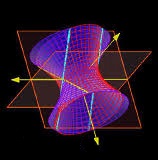December 2024
Why are parallel lines considered degenerate conics and hyperboloids considered standard quadrics? Lets follow some facts here, and highlight the ones that are inconsistent (pink). My only question is - Why are they inconsistent?
| 2D Conic Sections | 3D Quadric Surfaces |
|---|---|
| Parallel lines (cyan) can be rotated to form a hyperboloid of one sheet. | Hyperboloids of one sheet can be rotated to form a hyper-hyperboloid (which unimaginatively is normally also just called a hyperboloid). |
 |
|
| Parallel lines is the only conic section which does not occur with any planar intersection on the double cone. | Hyperboloids of one sheet do not occur with any field intersection on the double hypercone. |
| Parallel lines are considered degenerate. | Hyperboloids of one sheet are considered standard. |
| A hyperboloid of one sheet can be intersected to produce circles, ellipses, hyperbolas, parallel lines, and intersecting lines. | A hyper-hyperboloid of one sheet can be intersected to produce spheres, ellipsoids, hyperboloids, cylinders, and the double cone. |
| Intersecting lines are a specific case only of a double cone, a plane intersecting at its apex, and a hyperboloid of one sheet, a plane intersecting at its transverse axis. | The double cone is a specific case only of a double hypercone, a field intersecting at its apex, and a hyper-hyperboloid of one sheet, a field intersecting at its transverse axis. |
| When the transverse axis of a hyperboloid of one sheet approaches its asymptotes, it forms a double cone. | When the transverse axis of a hyper-hyperboloid of one sheet approaches its asymptotes, it forms a double hypercone. |
 |
|
| A parabola and a point are specific cases of the cone, the parabola intersecting through it on any plane parallel to a single line on its surface, having only an eccentricity of 1 and not appearing on the hyperboloid of one sheet. | A paraboloid and a point are specific cases of the hypercone, the paraboloid intersecting through it on any field parallel to a single line on its surface, having only an eccentricity of 1, and not appearing on the hyper-hyperboloid of one sheet. |
| Hyperbolas "of two sheets" are standard conics, but "hyperbolas of one sheet" are never mentioned. They can both be graphed with the same exact equation and viewed this way:
"One sheet" cyan "Two sheets" yellow |
Hyperboloids of one sheet and of two sheets are standard quadrics. They can only be represented with opposite signs for the variable side of the same exact equation. Ironically, graphing both in the same field with only the sign reversal on the variable side and splitting it down the middle of both symmetrically produces the exact same image below. |
 |
Conclusion: We should reevaluate conics/quadrics to include the hyperboloid/hyper-hyperboloid of one sheet as supersets wherein the double cone/hypercone are special cases, and since the 5D hyperboloid of one sheet encapsulates them all, simply call them hyperbolics.
We should also drop the notion that something isn't beautiful ("degenerate") without all the right curves, because it is effectively meaningless when viewing the whole.
Return to top
